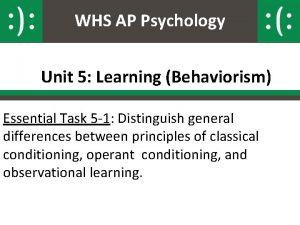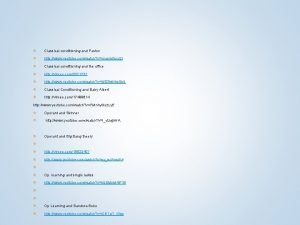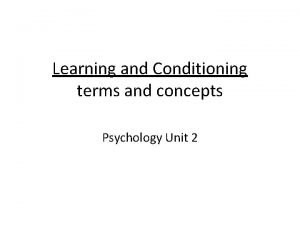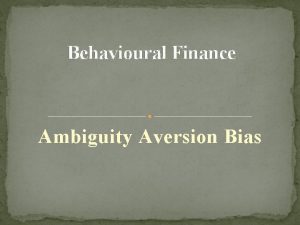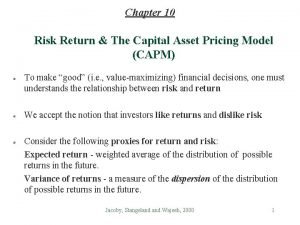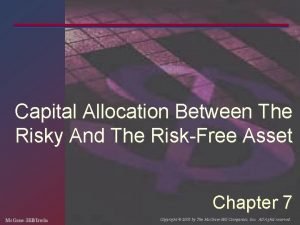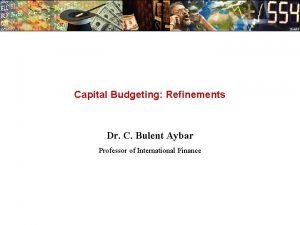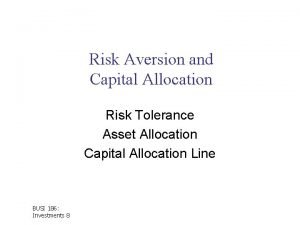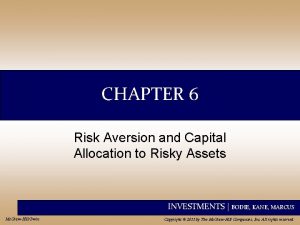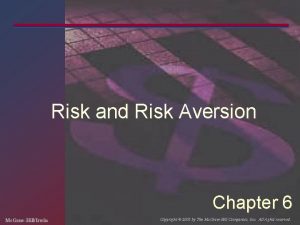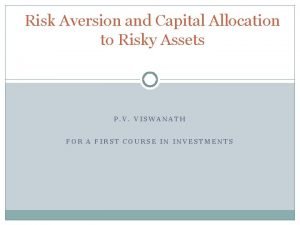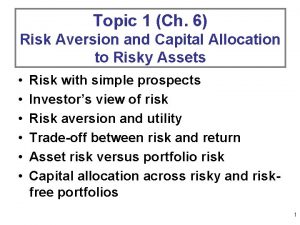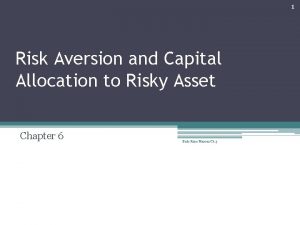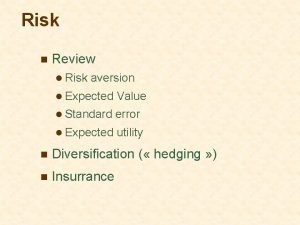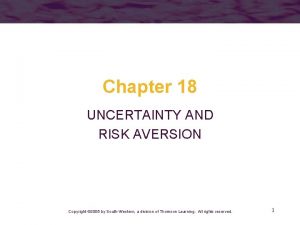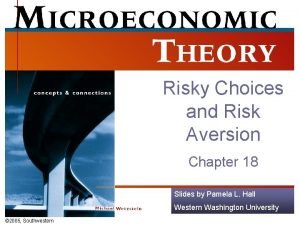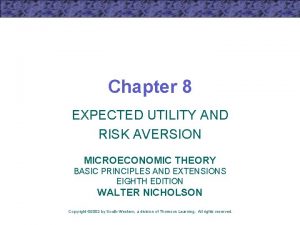6 1 CHAPTER 6 Risk Aversion and Capital





















- Slides: 21

6 -1 CHAPTER 6 Risk Aversion and Capital Allocation to Risky Assets INVESTMENTS | BODIE, KANE, MARCUS Mc. Graw-Hill/Irwin Copyright © 2011 by The Mc. Graw-Hill Companies, Inc. All rights reserved.

6 -2 Allocation to Risky Assets • Investors will avoid risk unless there is a reward. • The utility model gives the optimal allocation between a risky portfolio and a risk-free asset. INVESTMENTS | BODIE, KANE, MARCUS

6 -3 Risk and Risk Aversion • Speculation – Taking considerable risk for a commensurate gain – Parties have heterogeneous expectations INVESTMENTS | BODIE, KANE, MARCUS

6 -4 Risk and Risk Aversion • Gamble – Bet or wager on an uncertain outcome for enjoyment – Parties assign the same probabilities to the possible outcomes INVESTMENTS | BODIE, KANE, MARCUS

6 -5 Risk Aversion and Utility Values • Investors are willing to consider: – risk-free assets – speculative positions with positive risk premiums • Portfolio attractiveness increases with expected return and decreases with risk. • What happens when return increases with risk? INVESTMENTS | BODIE, KANE, MARCUS

6 -6 Mean-Variance (M-V) Criterion • Portfolio A dominates portfolio B if: • And INVESTMENTS | BODIE, KANE, MARCUS

6 -7 Capital Allocation Across Risky and Risk. Free Portfolios Asset Allocation: • Is a very important part of portfolio construction. • Refers to the choice among broad asset classes. Controlling Risk: • Simplest way: Manipulate the fraction of the portfolio invested in risk-free assets versus the portion invested in the risky assets INVESTMENTS | BODIE, KANE, MARCUS

6 -8 Basic Asset Allocation Total Market Value Risk-free money market fund $300, 000 $90, 000 Equities $113, 400 Bonds (long-term) Total risk assets $96, 600 $210, 000 INVESTMENTS | BODIE, KANE, MARCUS

6 -9 Basic Asset Allocation • Let y = weight of the risky portfolio, P, in the complete portfolio; (1 -y) = weight of risk-free assets: INVESTMENTS | BODIE, KANE, MARCUS

6 -10 The Risk-Free Asset • Only the government can issue default-free bonds. – Risk-free in real terms only if price indexed and maturity equal to investor’s holding period. • T-bills viewed as “the” risk-free asset • Money market funds also considered risk-free in practice INVESTMENTS | BODIE, KANE, MARCUS

6 -11 Portfolios of One Risky Asset and a Risk-Free Asset • It’s possible to create a complete portfolio by splitting investment funds between safe and risky assets. – Let y=portion allocated to the risky portfolio, P – (1 -y)=portion to be invested in risk-free asset, F. INVESTMENTS | BODIE, KANE, MARCUS

6 -12 Example Using Chapter 6. 4 Numbers rf = 7% rf = 0% E(rp) = 15% p = 22% y = % in p (1 -y) = % in rf INVESTMENTS | BODIE, KANE, MARCUS

6 -13 Example (Ctd. ) The expected return on the complete portfolio is the risk-free rate plus the weight of P times the risk premium of P INVESTMENTS | BODIE, KANE, MARCUS

6 -14 Example (Ctd. ) • The risk of the complete portfolio is the weight of P times the risk of P: INVESTMENTS | BODIE, KANE, MARCUS

6 -15 Example (Ctd. ) • Rearrange and substitute y=s. C/s. P: INVESTMENTS | BODIE, KANE, MARCUS

Figure 6. 4 The Investment Opportunity Set 6 -16 INVESTMENTS | BODIE, KANE, MARCUS

6 -17 Risk Tolerance and Asset Allocation • The investor must choose one optimal portfolio, C, from the set of feasible choices – Expected return of the complete portfolio: – Variance: INVESTMENTS | BODIE, KANE, MARCUS

6 -18 Figure 6. 8 Finding the Optimal Complete Portfolio Using Indifference Curves INVESTMENTS | BODIE, KANE, MARCUS

Passive Strategies: The Capital Market Line 6 -19 • The passive strategy avoids any direct or indirect security analysis • Supply and demand forces may make such a strategy a reasonable choice for many investors INVESTMENTS | BODIE, KANE, MARCUS

6 -20 Passive Strategies: The Capital Market Line • A natural candidate for a passively held risky asset would be a well-diversified portfolio of common stocks such as the S&P 500. • The capital market line (CML) is the capital allocation line formed from 1 -month T-bills and a broad index of common stocks (e. g. the S&P 500). INVESTMENTS | BODIE, KANE, MARCUS

6 -21 Passive Strategies: The Capital Market Line • The CML is given by a strategy that involves investment in two passive portfolios: 1. virtually risk-free short-term T-bills (or a money market fund) 2. a fund of common stocks that mimics a broad market index. INVESTMENTS | BODIE, KANE, MARCUS
 Risk aversion indifference curve
Risk aversion indifference curve Endowment effect and loss aversion
Endowment effect and loss aversion Business vs financial risk
Business vs financial risk Market risk credit risk operational risk
Market risk credit risk operational risk Operant conditioning ap psychology
Operant conditioning ap psychology Inequality aversion
Inequality aversion Ivan pavlov theory
Ivan pavlov theory Taste aversion
Taste aversion Ambiguity aversion bias
Ambiguity aversion bias Aversion therapy alcohol
Aversion therapy alcohol Aversion therapy evaluation
Aversion therapy evaluation Working capital management refers to
Working capital management refers to Difference between capital reserve and reserve capital
Difference between capital reserve and reserve capital Multinational capital structure
Multinational capital structure Difference between capital reserve and reserve capital
Difference between capital reserve and reserve capital Constant vs variable capital
Constant vs variable capital Multinational cost of capital and capital structure
Multinational cost of capital and capital structure Risk return and capital asset pricing model
Risk return and capital asset pricing model Capital budgeting under risk and uncertainty
Capital budgeting under risk and uncertainty Capital allocation line
Capital allocation line Risk and refinements in capital budgeting
Risk and refinements in capital budgeting Residual risk and secondary risk pmp
Residual risk and secondary risk pmp




